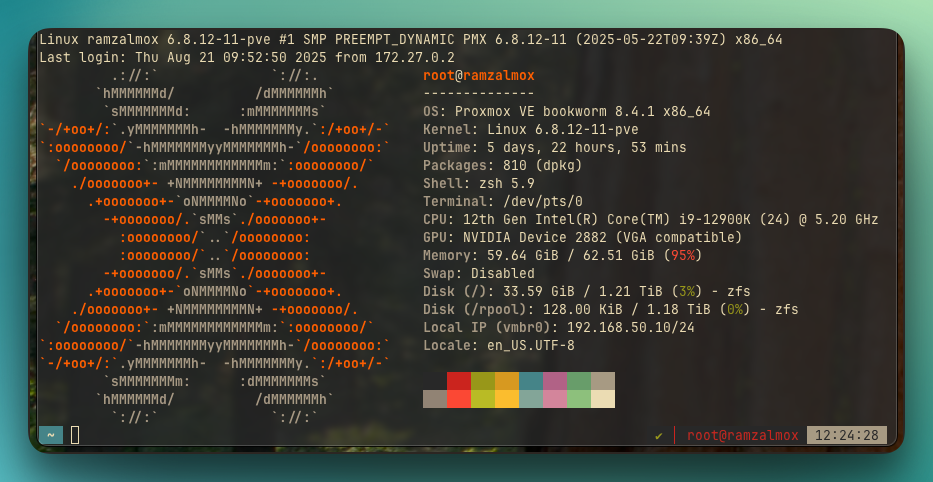My experience daily driving Linux for my gaming computer and why I'm switching back to Windows for games.

I want to start this article by noting that I use my desktop gaming computer exclusively for gaming. Nothing else, just games. Most of my daily tasks—computing, work, browsing, and media consumption—are handled on my MacBook or iPad. I’ve fallen in love with Unix-based operating systems and recently found great joy in exploring their many capabilities, particularly for self-hosting. macOS, being Unix-based, supports my enthusiasm for terminal-based workflows while running on hardware renowned for its performance and design. The heart of my homelab is a Proxmox virtualization server, from which I host multiple services, such as file sharing and media streaming. This terminal-based mindset has naturally led me to explore running Linux as my main OS on my gaming computer and given the advent of Linux support thanks to companies like Valve, my experience should be good, right? ...right?
Why switch in the first place?
Because....reasons
Linux is great. Let me rephrase.. Linux is rad.

Linux is rad because it’s a powerful, open-source operating system that offers unmatched flexibility and control. Its Unix-based roots provide a robust, terminal-driven environment perfect for tinkerers, developers, and self-hosting enthusiasts. With a vast ecosystem of distributions, you can tailor Linux to any need, from running a Proxmox homelab to hosting services like media servers, cloud storage, or moving to something truly FOSS in a time when Microsoft seems to be taking Windows in a direction that adds more bloat, actively makes changes that lessen user privacy, impose unwanted software, and pushes updates that can sometimes cause more harm than good.
Let’s dive into why Microsoft Windows is a bloated mess in 2025. Pre-installed apps like Candy Crush or Edge shoving itself in your face, hogging resources and slowing down even beefy gaming rigs. Recent updates, like the Windows 11 24H2 release, pile on more telemetry and “AI-powered” features (hello, Copilot) that feel like Microsoft’s trying to sell you their ecosystem rather than letting you just use your PC. Updates often break more than they fix, with reports of 24H2 causing HDD/SSD failures and data corruption.
Privacy? Forget it. Windows slurps up your data like a kid with a milkshake, tracking everything from your searches to app usage for “personalized ads” you can’t fully disable, even in Pro editions. The latest update doubled down, pushing cloud integrations and mandatory Microsoft accounts for basic features, which feels like a middle finger to user control. Compare that to Linux’s open-source freedom, where I decide what runs and what’s tracked—zero telemetry unless I say so.
The CachyOS Linux Experience
How's it going?
CachyOS and daily driving Linux is awesome. Daily driving CachyOS is a delight due to its unparalleled customization, privacy, freedom, and speed. It offers a rolling-release model and access to the Arch User Repository (AUR), letting me tailor every aspect of my system, from desktop environments to kernel optimizations. Its focus on privacy ensures zero telemetry and full control over my data, a refreshing contrast to mainstream operating systems such as windows. As a FOSS platform, CachyOS embodies freedom of choice, allowing me to modify or remove anything I don't need or see fit for my workflows.
Not all rainbows shine here
Issues and Problems
Graphics drivers are generally less mature and lack feature parity and reliability when compared with their Windows driver counterparts. Even issues such as GPU driver crashes happen more frequently and with less chance for quick recovery. Opening two accelerated applications at a time will almost certainly trigger a GPU driver crash within 10 minutes. This will leave me with a black screen, and my GPU fans whirring away at 100% until I reboot the computer.
My first real issue gaming on Linux arose when I launched DOOM: The Dark Ages on Linux. This game supports NVIDIA’s Multi-Frame Generation (MFG) technology, which uses AI inferencing to generate up to three additional frames per rendered frame, potentially boosting framerates significantly. While the game loads fine and base performance is solid, MFG support is broken under Linux. Enabling MFG results in a purple hue across the entire screen, rendering the game unplayable. This issue occurs with or without Gamescope, and the game crashes if you alt-tab with MFG enabled. As of my last test, this issue remains unresolved.
Games not on Steam, like World of Warcraft, present unique challenges on Linux. In 2025, I still enjoy this repetitive, time-gated relic from 2004, I am currently running it through Lutris on CachyOS. Lutris, a gaming platform often installed as a Flatpak, uses compatibility layers like Wine and Proton to manage World of Warcraft via Battle.net, which lacks native Linux support. This setup requires jumping through hoops, such as tweaking Wine versions to fix Battle.net update errors or configuring DXVK (Vulkan based translation layer) for optimal performance. This presents itself with its own series of problems. Even so much so as updating your Flatpak graphics driver separately on Linux because Flatpak applications run in a sandboxed environment with their own runtime dependencies, including drivers like NVIDIA’s, which are isolated from your system’s native package manager. To add to more of the oddities, any window with graphics acceleration that was open at the time I exited out of World of Warcraft now had the WoW Gauntlet cursor in that window instead of the normal Linux desktop cursor. This could be a Wine/X11 quirk, so I figured I'd include it here.

Recently, when doing some higher level Mythic+ keys with the boys, I noticed that all of my inputs were not registering in game. I originally chalked this up to my internet frequently serving me RTOs (Request Timed Out - a response that typically indicates packet loss) at night, but after running a continuous ping command from terminal, I discovered it was something else entirely. Linux jank. Given the smaller user-base of Linux users out in the wild, tracking down the specific problem you have may be difficult, but I was able to find some users with similar issues. None of which are true fixes or provide resolution.
Lastly is anti-cheat. Developers such as Bungie, who make the popular online shooter, Destiny 2, employ the anti-cheat software known as BattlEye, which is incompatible with Linux. While you can install and play Destiny 2 under Linux, Bungie has taken the stance that any user doing so will result in a permanent ban,
If your game uses any sort of Ring 0 or kernel level anti-cheat... Do not pass go, do not play, don't even think of getting this to work under Linux. Ring 0 is the highest privilege level in a CPU’s protection ring architecture, where the operating system kernel runs with unrestricted access to hardware and system resources (e.g., memory, CPU, GPU). It’s contrasted with Ring 3, where user applications (like games or browsers) run with limited access.
On Windows, kernel-level anti-cheats (e.g., Vanguard, BattlEye) use filter drivers to monitor system activity at Ring 0, detecting cheats that manipulate game memory or drivers. Linux’s kernel doesn’t expose equivalent APIs, and its internal structures change frequently across versions, making it difficult to write stable kernel modules for anti-cheat. Most anti-cheat vendors don’t develop Linux-specific kernel modules due to this complexity and the smaller Linux gaming userbase.
Kernel-level anti-cheat can also introduce vulnerabilities, such as backdoors or exploits, as seen in cases like ESEA’s 2013 bitcoin mining scandal or remote code executions.
Recently, as wild as this seems, the kernel level anti-cheats of the popular online shooters, Valorant, and the open beta for the upcoming Battlefield 6, are fighting for Ring 0 supremacy on your computer, flagging each other as malicious in some sort of dystopian Spy vs. Spy routine. One user on reddit posted that Battlefield 6 told him to uninstall Valorant.

One might view this as a strength of Linux by preventing end users from installing this free-access malware on your machine unknowingly. I would tend to agree. However, as more and more users are willing to trade lack of privacy and control for features and convenience, it is likely that more games and programs will invade our security privacy, and given the latest fiasco between Valorant and Battlefield 6, our usability.
This leaves me (along with privacy and security focused individuals) at an impasse. What levels of acceptable risk and privacy are we willing to sacrifice?
The Solution
Where do we go from here?
Sadly, I believe the best course of action is to treat my gaming computer as I always have, make it be the best purpose driven gaming tool I can. For everything else, I have my Macbook and iPad.
For me, that involves reluctantly switching back to Windows, isolating the machine in its own VLAN, and using tools such as Talon or The Ultimate Windows Utlity by CTT to disable as much telemetry and remove as much bloat as possible.
As someone who strives for high availability, what about high compatibility and support for games? Windows is unmatched here sadly. Windows has the widest game compatibility, the greatest driver support, and the least amount of traction between me and games. As someone with a lot going on personally and professionally, the time I have to game... I just want to game. I don't want to have to figure out how to game.
I strictly use this gaming computer for one thing. Games. I don't bank. I don't check my portfolio. I don't manage servers. I don't do anything sensitive. I just play games. Unless people wake up and Unix based operating systems get more attention, I believe this is the best path forward to have a no-fuss cutting edge gaming experience.